Leyton Orient
The club's original incarnation was as an offshoot of Glyn Cricket Club, formed to provide members with a winter activity in the East End of London. The club became Eagle CC in 1886. In 1888, at the suggestion of Jack R Dearing, who worked for the Orient shipping line (later P&O), the club became Orient FC and football became their main activity. Ten years later, in 1898, the club changed its name to Clapton Orient FC in a bid to attract wider support. During this period the club wore plain red shirts with a large capital O on the back: they are known to this day as "The O's."
In 1905, Clapton Orient, playing in the Second Division of the Southern League, applied for election to the Football League Second Division. On the first ballot, Orient's application was roundly rejected but a subsequent motion to extend the League was then passed and the "O"s were elected at the second attempt. At the time they wore a unique shirt of white, green and red stripes, the first of many unconventional designs. Orient made little impact after surviving re-election in their first season but by the time League football was suspended in 1915, they were finishing consistently in the top half of Division Two. From 1910 the team's shirts were adorned with a bold red V, which became their signature kit until the 1930s.
No fewer than 41 players and staff volunteered for service in the Great War with the 17th Middlesex ("The Footballers Battalion"), the O's being the first English Football League side to enlist en masse. Three players lost their lives during the Battle of the Somme in 1916 while many more were wounded (i).
During the inter-war period, Orient struggled and in 1929, the club was relegated to Division Three (South). In 1932 a new design of broad red and white hoops was adopted, worn with distinctive all-white sleeves from 1935. In 1937, it was decided to move the club to north London. They continued to play as Clapton Orient until 1946 when, having narrowly avoided bankruptcy, the club's name was changed to Leyton Orient. The old red and white strip was replaced with blue and white although for a few years, shirts featured a bold "V", a reminder of an earlier era.
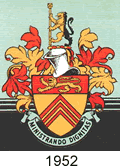 The change of location prompted the club to adopt a new crest, based on the coat of arms of the Borough of Leyton. This was worn on on the players' shirts in the 1952-53 season.
The change of location prompted the club to adopt a new crest, based on the coat of arms of the Borough of Leyton. This was worn on on the players' shirts in the 1952-53 season.
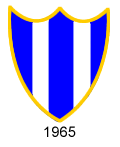 In 1956 Orient won the Division Three (South) championship and in 1962 this unfashionable club was promoted to the First Division, their highest achievement to date. Well out of their depth, the "O"s were relegated after only one season and four years later, the club was back in Division Three. Although the club wore plain shirts throughout this period, a curious striped shield appeared in the latter part of the 1964-65 season.
In 1956 Orient won the Division Three (South) championship and in 1962 this unfashionable club was promoted to the First Division, their highest achievement to date. Well out of their depth, the "O"s were relegated after only one season and four years later, the club was back in Division Three. Although the club wore plain shirts throughout this period, a curious striped shield appeared in the latter part of the 1964-65 season.
In November 1966, the name Orient FC was adopted: most commentators believed this was a modern Sixties gimmick, not realising that the club had played under the same title in Victorian times. 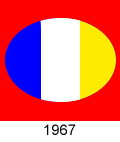 A simple all-red strip was adopted the following season, embellished with a yellow, white and blue badge, the colours of the modern P&O Shipping Line.
A simple all-red strip was adopted the following season, embellished with a yellow, white and blue badge, the colours of the modern P&O Shipping Line.
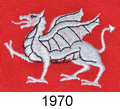 The club continued to lurch from one financial crisis to another but survived on the generosity of its loyal fans. Orient won the Division Three championship in 1970 and returned to the Second Division where they remained for twelve years. Perhaps prompted by this success, the club replaced the tricolour badge with a rather more impressive griffin.
The club continued to lurch from one financial crisis to another but survived on the generosity of its loyal fans. Orient won the Division Three championship in 1970 and returned to the Second Division where they remained for twelve years. Perhaps prompted by this success, the club replaced the tricolour badge with a rather more impressive griffin.
A more elaborate crest was designed in 1976 and worn for the first time in 1977 on the smart all-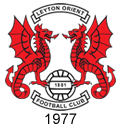 white kit with bold vertical red "braces." This featured a pair a wyverns, a mythical creature associated with the River Thames, harking back to the club's connection with the old Port of London. The Os reached the FA Cup semi-finals in 1978, where they were eliminated by Arsenal, ensuring the popularity of the new white look and crest.
white kit with bold vertical red "braces." This featured a pair a wyverns, a mythical creature associated with the River Thames, harking back to the club's connection with the old Port of London. The Os reached the FA Cup semi-finals in 1978, where they were eliminated by Arsenal, ensuring the popularity of the new white look and crest.
By 1985 the club had descended to the Fourth Division and two years later, it was decided to revive the old name of Leyton Orient (although the club did not change colours this time and continued to play in red and white). Four years later, the club was promoted back to Division Three via the play-offs but in 1995, on the verge of bankruptcy once again, Orient were relegated back to the lowest Division (now Division Three). They survived as they always have done and in 2006 they won promotion back to the third tier (League One).
During the 1990s the "O"s wore some spectacular kits including a revived version of the white shirts with a red "V" that was the club's signature kit in the 1920s and a chequered shirt (revived in 2001). In the new millennium the club has favoured all-red kits with a variety of entertaining trimmings.
